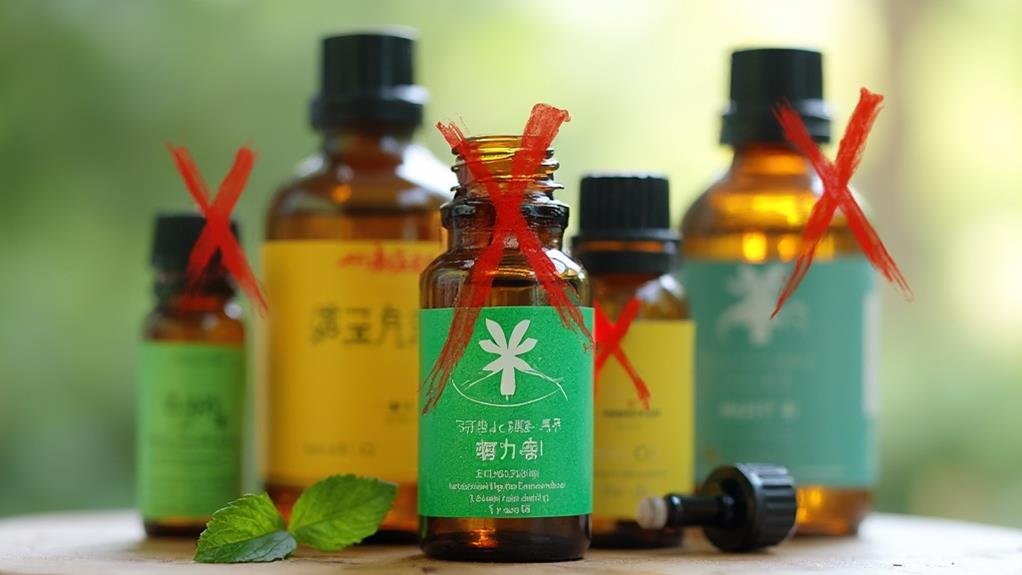What Oils Should Not Be Mixed Together?
Blending essential oils can be a great way to create unique aromas and therapeutic effects.
However, certain oils should never be mixed together due to potential adverse reactions, skin irritation, or diminished therapeutic benefits.
Avoid mixing mint with eucalyptus, citrus oils with cinnamon, peppermint with wintergreen, and bergamot with lemon due to risks of skin irritation, respiratory issues, and photosensitivity. Cedarwood and juniper berry have counteracting effects. Always check compatibility and dilute properly.
In this article, we’ll explore the oils that should not be combined, the reasons behind their incompatibility, and how to ensure you use essential oils safely.
Why Avoid Certain Essential Oil Combinations?
When blending essential oils, it’s crucial to know which combinations to avoid. Mixing the wrong oils can result in:
- Increased skin sensitivity and irritation
- Respiratory issues
- Photosensitivity leading to severe sunburns
- Negative interactions with medications
- Harmful effects on pets and children
Understanding these potential risks can help you create safe and effective blends for aromatherapy, skincare, and other uses.
Essential Oil Combinations to Avoid

Mint and Eucalyptus Oils
Mixing mint essential oils (such as peppermint or spearmint) with eucalyptus oil can significantly increase the risk of skin irritation and respiratory issues. Both oils contain potent compounds that, when combined, can cause adverse reactions such as:
- Excessive cooling effects on the skin
- Breathing difficulties, especially for individuals with asthma or other respiratory conditions
Avoid mixing mint with eucalyptus to prevent these reactions.
Citrus Oils and Cinnamon Oil
Combining citrus oils (like lemon or grapefruit) with cinnamon oil can cause severe skin and mucous membrane irritation. This happens because:
- Limonene in citrus oils enhances the irritating effects of cinnamaldehyde in cinnamon oil.
- Furanocoumarins in oils like grapefruit increase the risk of photosensitivity, leading to sunburn when exposed to UV light.
Avoid using these oils together, especially in skincare products, to prevent discomfort and skin damage.
Peppermint and Wintergreen Oils
While both peppermint and wintergreen oils have cooling properties, their combination can amplify irritation. This blend can lead to:
- Digestive issues, especially if ingested
- Bleeding risks, due to methyl salicylate in wintergreen
- Increased skin irritation, particularly for people with sensitive skin
Never mix peppermint and wintergreen oils, especially for topical or internal use.
Bergamot and Lemon Oils
Bergamot and lemon oils are both known to cause photosensitivity, which can lead to severe sunburns, blisters, and long-term skin damage when exposed to UV light. This effect is heightened when these oils are used together. To safely use these oils:
- Apply them in areas not exposed to direct sunlight for at least 12 hours.
- Dilute them properly with a carrier oil to minimize the risk of adverse skin reactions.
Cedarwood and Juniper Berry Oils
Combining cedarwood and juniper berry essential oils can create a clash of effects. Cedarwood has calming properties, while juniper berry oil is stimulating, which means they can work against each other. This combination can:
- Disrupt the intended relaxing effects of cedarwood
- Lead to an overpowering and unpleasant aroma
Avoid mixing these oils to prevent these counteracting effects.
Essential Oils That Are Harmful to Children and Pets

Oils to Avoid Around Children
Children have developing nervous systems that are more sensitive to the potent compounds in essential oils. The following oils should not be used around children:
- Peppermint, lemongrass, and tea tree oils: Can cause skin irritation, allergic reactions, or respiratory issues.
- Eucalyptus, rosemary, and camphor oils: High in menthol or 1,8-cineole, which can overwhelm a child’s nervous system.
Always dilute essential oils and use them cautiously around children.
Dangerous Oil Combinations for Pets
Essential oils can be particularly dangerous for pets, especially cats and dogs, whose livers cannot process these oils as effectively as humans can. Hazardous combinations include:
- Peppermint and eucalyptus oils: Can cause hypothermia, tremors, and seizures in pets.
- Melaleuca (tea tree) oil with lavender and chamomile: Highly toxic to pets, with an increased risk when these oils are combined.
Never use these oils around pets, and consult a veterinarian before introducing any essential oils into your home.
Check out this article.
Other Essential Oil Combinations to Avoid
Oils That Irritate the Skin
Some oils are more likely to cause skin irritation when combined due to their strong active compounds. These include:
- Clove oil (high in eugenol)
- Cinnamon oil (contains cinnamaldehyde)
- Oregano oil (rich in carvacrol)
- Thyme oil (contains thymol)
- Lemongrass oil (high in citral)
To avoid irritation, always dilute these oils in a carrier oil and perform patch tests before applying them to larger areas of the skin.
Oils That Cause Allergic Reactions
Essential oils can also trigger allergic reactions, particularly when combined with other allergenic oils. Common allergenic oils include:
- Cinnamon oil (cinnamaldehyde can cause respiratory problems)
- Lemongrass oil (citral triggers skin reactions)
- Bergamot oil (bergapten increases skin photosensitivity)
If you experience symptoms of an allergic reaction, such as rashes, hives, or difficulty breathing, stop using the oil immediately.
How to Safely Blend Essential Oils
Check Compatibility
Before blending essential oils, always check for potential incompatibilities. Use trusted resources or consult a certified aromatherapist to ensure your blends are safe.
Dilute and Patch Test
Always dilute essential oils with a carrier oil, and perform a patch test on a small area of your skin before applying it more broadly.
Avoid Prolonged Sun Exposure
If you use photosensitizing oils like bergamot or lemon, avoid sun exposure for at least 12 hours after application to prevent adverse skin reactions.
Conclusion
Blending essential oils can offer therapeutic benefits, but it’s essential to know which oils should not be mixed together.
By understanding the risks of combining certain oils—whether due to skin irritation, respiratory issues, or photosensitivity—you can ensure your essential oil blends are both safe and effective.
Always take precautions, such as dilution and patch testing, to minimize risks and maximize the benefits of essential oils.







